How to choose a PoE switch for projects of different scale. Examples from practice
Video surveillance, Wi-Fi networks and even cash equipment: in our portfolio there are projects for which more than one hundred of our PoE switches were purchased. We want to tell you about the use of PoE equipment, some of the nuances in the selection of it - and the most delicious, we saved, of course, at the end.
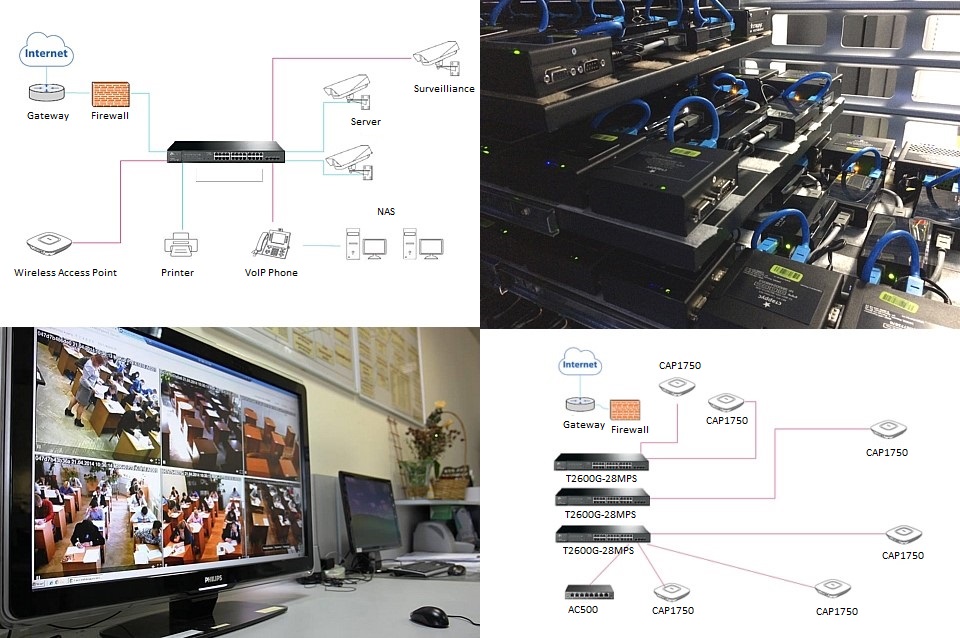
First, a few words about the technology and standards.
PoE (Power over Ethernet) allows the transmission of electrical energy to a remote device connected to the network via Ethernet channel protocol (Ethernet / Fast Ethernet / Gigabit Ethernet). Energy transfer is carried out using the same UTP (Unshielded Twisted Pair) cable.
')

The main advantage of PoE is in reducing infrastructure costs. Of course, the power equipment has a higher price (CAPEX), but the investment will quickly pay off during implementation and in service (OPEX), especially if you take into account all the associated costs. For example, one cannot ignore the cost of pulling a power cable and installing additional sockets when using a traditional power scheme. In addition, this approach enhances the aesthetic component.
The second advantage is the ease of use of the final equipment, fed through a single data cable.
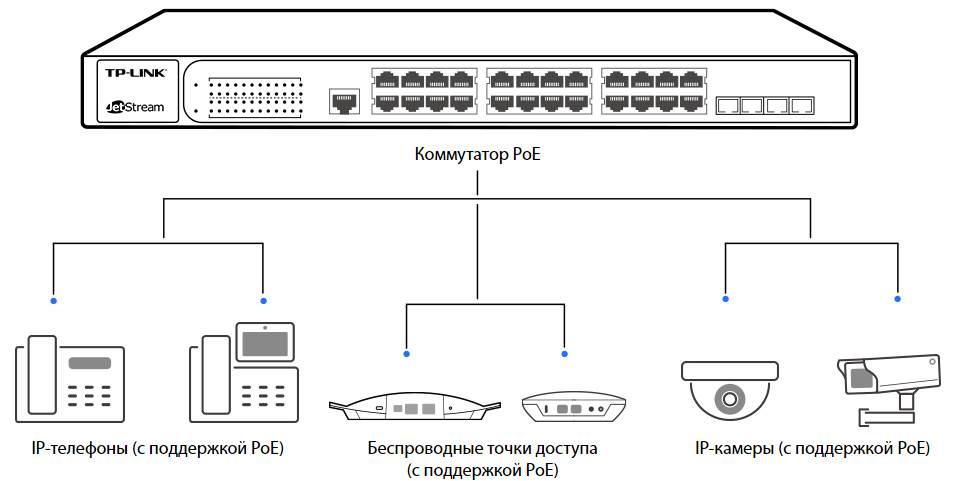
Energy distribution using PoE allows you to centralize the management of the power supply system, monitor the power consumption and turn on / off consumers, including automatically on a schedule. The consequence of centralization will be increased reliability and controllability of the entire system as a whole. For example, the network management system used in an organization may collect power consumption statistics using the SNMP protocol.
Another advantage of using PoE is security, as it provides intelligent energy transfer that protects terminal equipment from overload or power failure.
The flexibility provided by technology allows you to place powered equipment anywhere without being connected to electrical networks.
Do not forget about the ease of installation and speed of network deployment. Less wired connections - shorter implementation time.
Today, in the home and corporate networks, as well as in networks of telecom operators, two standards of energy transmission over twisted pair are widely used: IEEE 802.3af-2003 and 802.3at-2009. The main difference between the two is the maximum transmit power. The IEEE 802.3af-2003 standard provides power supply of up to 15.4 watts (minimum 44 V and 350 mA) over two pairs of conductors, whereas when using IEEE 802.3at-2009 (also called PoE + or PoE plus), the maximum power rises to 25, 5 watts. Such enormous power may be required, for example, when using surveillance cameras with servo (rotary), or placed in specialized heated boxes.
IP phones with additional control panels / extensions may also not fit into the standard energy budget offered by the 802.3af standard. Not to mention the emerging on the market of small switches, which are themselves capable of receiving power using PoE.
However, not all of the indicated power is available to consumer devices. For example, when using the 802.3af standard at a distance of one hundred meters, only 12.95 watts will be available to the final device due to the resistance of the wires and other losses.
Many corporate customers want to know the answers to a number of questions before purchasing equipment of one or another vendor. Have there been successful implementations? What equipment was used in which cases and why? How many devices are used? What is the coverage area? We will give a few examples of the successful implementation of TP-Link equipment in the networks of some of our major customers that were made in 2016/2017, as well as answer some of these questions.
The task of powering cameras is one of the standard when using PoE switches. Our equipment is used by various retailers, including the X5 RETAIL GROUP group of companies. In the network of Pyaterochka supermarkets, belonging to the group, a video surveillance system was developed, built on the basis of PoE switches TP-Link T1500-28PCT . This model is designed for installation in a telecommunications rack, it has 24 Fast Ethernet ports, four Gigabit Ethernet connectors and two combined Gigabit SFP slots. The strengths of the switch can also include the built-in protection and prioritization of traffic. Initially, Pyaterochka began building infrastructure with competitor's 16-port switches, but then we turned our attention to our similarly priced 24-port models, which ultimately helped the company save considerably thanks to a larger number of connected cameras.

TP-Link T1500-28PCT
PoE technology in this project was also used to power some access points and VoIP phones. And other equipment (servers, printers, network security devices) was connected using standard Gigabit Ethernet interfaces. In total, about 2,000 of our supply switches were installed in the supermarkets of the network.
Another large federal chain of stores for the home and garden also built its video surveillance system based on the T1500-28PCT model: the 180-watt energy budget was ideally suited to their requirements. Typical internal cameras for video surveillance belong to the second class of powered devices from the point of view of the IEEE 802.3af standard and fit into the power consumption range from 3.8 to 6.5 watts. In their video surveillance system, internal non-rotational camera models were used (without servo drives and heated enclosures), which made it possible to provide them with power even using switches that do not have the maximum energy budget.
We have one more example of successful large-scale implementation of our PoE switches. In this case, we are talking about the model T2600G-28MPS , in which for 24 gigabit PoE ports, power is allocated up to 384 watts. On the basis of this switch (together with TRASSIR), a video surveillance system was deployed in the network of family hypermarkets (in total, the customer needed about 750 switches with PoE + support to build a large-scale video surveillance system).
One of the special cases of application was the organization of video surveillance during the Unified State Exam in 2017. For this purpose, we provided the T1600G-28PS switches : 24 Gigabit PoE + ports with support for 802.3at / af standards and an energy budget of 192 watts. The choice on the T1600G instead of the T1500 fell because of the gigabit ports that the installed cameras also possessed.
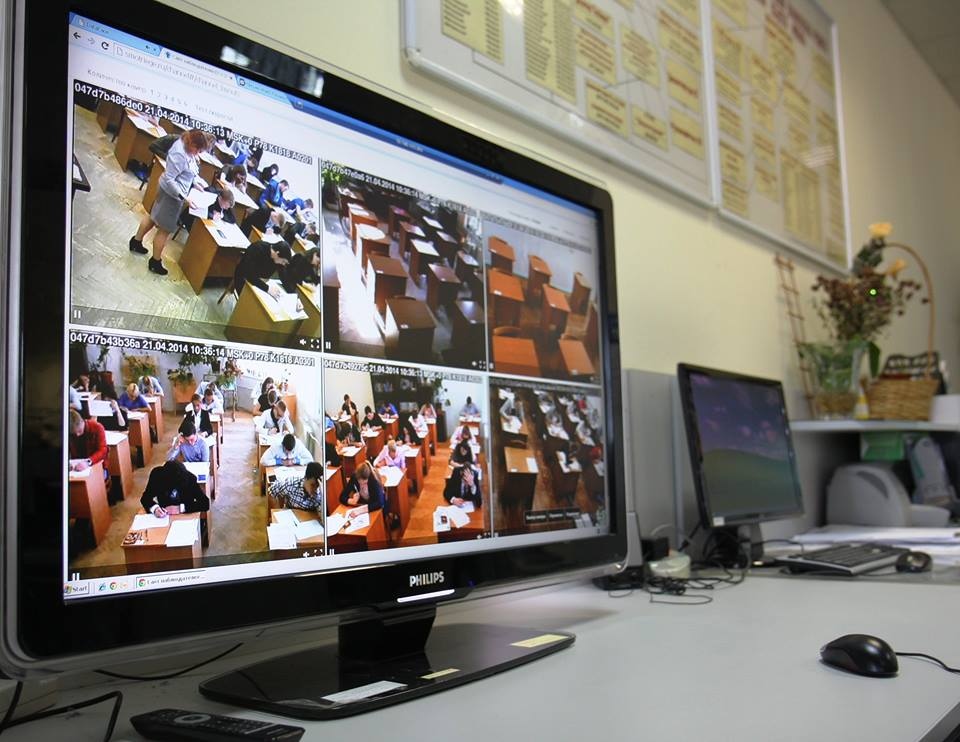
Photo: opennov.ru
The difference between the T1600G-28PS and T2600G-28MPS is that the former has a lower energy budget, but is more preferable in terms of price.
In general, university networks are interesting for their heterogeneity. Here we would like to mention projects in two large educational institutions of our country. In both cases, T2600G-28MPS switches (TL-SG3424P) with a large energy budget (up to 390 W) were used. These switches belong to the JetStream 2+ line and have 24 copper gigabit ports with PoE + 802.3at / af support, as well as four SFP slots. The maximum device performance is 56 Gbps or 41.7 million packets per second. Model T2600G-28MPS can be installed in a 19 "telecommunications rack or placed on a table or shelf.
In the first case, a large-scale video surveillance system was deployed, the terms of reference for which required installing switches with an energy budget of at least 380 watts. Also in this case it was necessary to ensure security already at the level of access to the network. Both of these conditions and determined the choice of model.
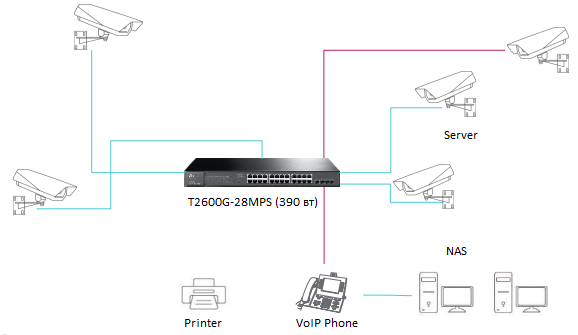
On the territory of another educational institution, the T2600G-28MPS switches were used to organize a wired segment that supports the operation of a wireless Wi-Fi network. This model was chosen because the power consumption of access points is significantly higher than standard IP cameras.
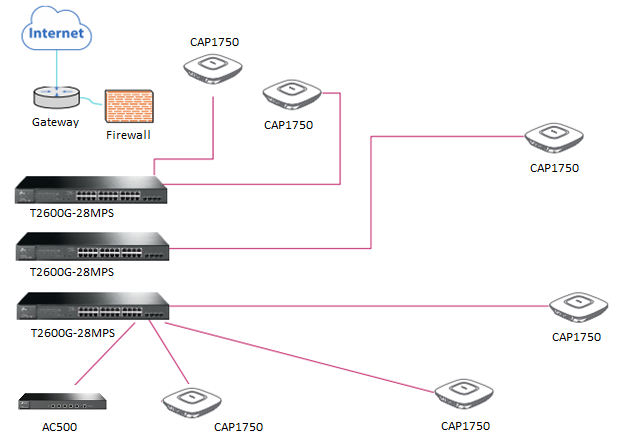
The wireless functions were assigned to the TP-Link AC500 controller and the CAP1750 access point, which we already described in detail in our blog earlier.
Of course, compact models with PoE, designed to work outside the specialized server, are also a success. For example, fanless TL-SG108PE . This switch has eight gigabit ports, four of which allow powering connected equipment (up to 15.4 watts per port). The total PoE budget of the device is 55 watts. These switches were used in building local networks in the federal retail chain of shoe stores and another popular pharmacy chain. In both cases, our PoE switches were used to power surveillance cameras and provide power to access points to create Wi-Fi networks, also built on TP-Link.
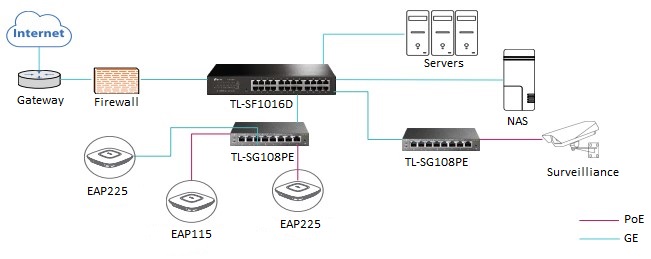
We also have non-standard applications. One of the non-trivial projects was implemented jointly with the company CloudKassir . In July 2017, a law came into force that obliges online stores to conduct payments through cash registers and issue electronic checks. Tax in real time sees the revenue of the business, and the buyer always has a document confirming the transaction.
All this is based on cash registers connected to the Internet. The seller can place such a cash register at home, provide power, access to the global network, and so on. But it can also use the service of specialized companies that provide cash from the cloud for rent. In the construction of one of these services we took part. It is worth noting that the decision was built at the time of an acute shortage of cash equipment, and this was due to some of the adopted technical solutions.
The network is based on TP-Link T1600G-52PS rack-mounted switches . This model not only performs traffic switching, but also provides cash desk power. Unfortunately, the used cash desk models did not support Power over Ethernet technology (and were not intended for rack mounting at all), so we had to add the structure with PoE-splitters located along with the online cash registers on specialized sliding shelves mounted in a standard telecommunications rack.

The applied solution made it possible to obtain a gain in the used space inside the rack (due to the absence of traditional power supplies), and also to provide greater flexibility in the management of the power system. Compactness of the solution in the future will save on rental racks and, in general, improve the efficiency of the customer's IT system.
The non-standard solution in this case is that PoE is used inside the server rooms of the data center, where there is usually no shortage of power supply, and the installation density of the equipment is quite high.
As we see, equipment with PoE is often used to organize large-scale video surveillance systems and to provide wireless access to the network in large areas. And here everything is logical, but there is one thing: in our practice, the choice of equipment of a manufacturer in Russian projects is often determined by the degree of vendor involvement in the project itself. And this is not only or not so much about the guarantee or support (for some models we have a limited lifetime warranty, in some cases we can offer a free forward replacement), but rather the flexibility of the manufacturer’s approach to the projects using its equipment.
For example, in a number of projects, customization of device firmware played a major role in choosing equipment. Also, the possibility of free preliminary testing of equipment does not go unnoticed. Well, a full radio frequency survey and planning, carried out at the stage of project development, ensured the choice of our wireless equipment in universities. In other words, we tried.
In conclusion, we would like to help you understand the model range of our switches and provide explanations on the model numbering. For example, consider the switch T2600G-28MPS.
The number after T indicates the control level: 1 - Smart, 2 - managed switch L2 / L2 +, 3 - switch with functions of the third level.
For managed switches, the second figure in the model name means the basic set of firmware functions and the hardware platform: 5 — standard L2 functions, 6 — support for static routing, 7 — availability of 10 Gigabit Ethernet interfaces or support for physical stacking.
The letter after the numbers indicates the basic port speeds: G - Gigabit Ethernet, X - 10 Gigabit Ethernet, the absence of designation indicates that the switch interfaces support Fast Ethernet.
The total number of ports is encoded in the second group of numbers.
The last set of letters is used to indicate the type of interfaces and other hardware characteristics: T - UTP ports, P - switch with PoE support, MP - switch with increased energy budget, S - independent SFP Uplink ports, and so on.
From the above, it turns out that the model T2600G-28MPS is a L2 / L2 + TP-Link switch with support for static routing and an increased energy budget, with 28 ports operating at 1 Gbit / s, and also having independent Uplink interfaces, intended for SFP installation.
A comparative review of all models is always available here.

First, a few words about the technology and standards.
A few words about PoE
PoE (Power over Ethernet) allows the transmission of electrical energy to a remote device connected to the network via Ethernet channel protocol (Ethernet / Fast Ethernet / Gigabit Ethernet). Energy transfer is carried out using the same UTP (Unshielded Twisted Pair) cable.
')

The main advantage of PoE is in reducing infrastructure costs. Of course, the power equipment has a higher price (CAPEX), but the investment will quickly pay off during implementation and in service (OPEX), especially if you take into account all the associated costs. For example, one cannot ignore the cost of pulling a power cable and installing additional sockets when using a traditional power scheme. In addition, this approach enhances the aesthetic component.
The second advantage is the ease of use of the final equipment, fed through a single data cable.

Energy distribution using PoE allows you to centralize the management of the power supply system, monitor the power consumption and turn on / off consumers, including automatically on a schedule. The consequence of centralization will be increased reliability and controllability of the entire system as a whole. For example, the network management system used in an organization may collect power consumption statistics using the SNMP protocol.
Another advantage of using PoE is security, as it provides intelligent energy transfer that protects terminal equipment from overload or power failure.
The flexibility provided by technology allows you to place powered equipment anywhere without being connected to electrical networks.
Do not forget about the ease of installation and speed of network deployment. Less wired connections - shorter implementation time.
Today, in the home and corporate networks, as well as in networks of telecom operators, two standards of energy transmission over twisted pair are widely used: IEEE 802.3af-2003 and 802.3at-2009. The main difference between the two is the maximum transmit power. The IEEE 802.3af-2003 standard provides power supply of up to 15.4 watts (minimum 44 V and 350 mA) over two pairs of conductors, whereas when using IEEE 802.3at-2009 (also called PoE + or PoE plus), the maximum power rises to 25, 5 watts. Such enormous power may be required, for example, when using surveillance cameras with servo (rotary), or placed in specialized heated boxes.
IP phones with additional control panels / extensions may also not fit into the standard energy budget offered by the 802.3af standard. Not to mention the emerging on the market of small switches, which are themselves capable of receiving power using PoE.
However, not all of the indicated power is available to consumer devices. For example, when using the 802.3af standard at a distance of one hundred meters, only 12.95 watts will be available to the final device due to the resistance of the wires and other losses.
Successful projects
Many corporate customers want to know the answers to a number of questions before purchasing equipment of one or another vendor. Have there been successful implementations? What equipment was used in which cases and why? How many devices are used? What is the coverage area? We will give a few examples of the successful implementation of TP-Link equipment in the networks of some of our major customers that were made in 2016/2017, as well as answer some of these questions.
CCTV
The task of powering cameras is one of the standard when using PoE switches. Our equipment is used by various retailers, including the X5 RETAIL GROUP group of companies. In the network of Pyaterochka supermarkets, belonging to the group, a video surveillance system was developed, built on the basis of PoE switches TP-Link T1500-28PCT . This model is designed for installation in a telecommunications rack, it has 24 Fast Ethernet ports, four Gigabit Ethernet connectors and two combined Gigabit SFP slots. The strengths of the switch can also include the built-in protection and prioritization of traffic. Initially, Pyaterochka began building infrastructure with competitor's 16-port switches, but then we turned our attention to our similarly priced 24-port models, which ultimately helped the company save considerably thanks to a larger number of connected cameras.

TP-Link T1500-28PCT
PoE technology in this project was also used to power some access points and VoIP phones. And other equipment (servers, printers, network security devices) was connected using standard Gigabit Ethernet interfaces. In total, about 2,000 of our supply switches were installed in the supermarkets of the network.
Another large federal chain of stores for the home and garden also built its video surveillance system based on the T1500-28PCT model: the 180-watt energy budget was ideally suited to their requirements. Typical internal cameras for video surveillance belong to the second class of powered devices from the point of view of the IEEE 802.3af standard and fit into the power consumption range from 3.8 to 6.5 watts. In their video surveillance system, internal non-rotational camera models were used (without servo drives and heated enclosures), which made it possible to provide them with power even using switches that do not have the maximum energy budget.
We have one more example of successful large-scale implementation of our PoE switches. In this case, we are talking about the model T2600G-28MPS , in which for 24 gigabit PoE ports, power is allocated up to 384 watts. On the basis of this switch (together with TRASSIR), a video surveillance system was deployed in the network of family hypermarkets (in total, the customer needed about 750 switches with PoE + support to build a large-scale video surveillance system).
CCTV on the exam
One of the special cases of application was the organization of video surveillance during the Unified State Exam in 2017. For this purpose, we provided the T1600G-28PS switches : 24 Gigabit PoE + ports with support for 802.3at / af standards and an energy budget of 192 watts. The choice on the T1600G instead of the T1500 fell because of the gigabit ports that the installed cameras also possessed.

Photo: opennov.ru
The difference between the T1600G-28PS and T2600G-28MPS is that the former has a lower energy budget, but is more preferable in terms of price.
Networks in universities
In general, university networks are interesting for their heterogeneity. Here we would like to mention projects in two large educational institutions of our country. In both cases, T2600G-28MPS switches (TL-SG3424P) with a large energy budget (up to 390 W) were used. These switches belong to the JetStream 2+ line and have 24 copper gigabit ports with PoE + 802.3at / af support, as well as four SFP slots. The maximum device performance is 56 Gbps or 41.7 million packets per second. Model T2600G-28MPS can be installed in a 19 "telecommunications rack or placed on a table or shelf.
In the first case, a large-scale video surveillance system was deployed, the terms of reference for which required installing switches with an energy budget of at least 380 watts. Also in this case it was necessary to ensure security already at the level of access to the network. Both of these conditions and determined the choice of model.

On the territory of another educational institution, the T2600G-28MPS switches were used to organize a wired segment that supports the operation of a wireless Wi-Fi network. This model was chosen because the power consumption of access points is significantly higher than standard IP cameras.

The wireless functions were assigned to the TP-Link AC500 controller and the CAP1750 access point, which we already described in detail in our blog earlier.
Examples of building small networks
Of course, compact models with PoE, designed to work outside the specialized server, are also a success. For example, fanless TL-SG108PE . This switch has eight gigabit ports, four of which allow powering connected equipment (up to 15.4 watts per port). The total PoE budget of the device is 55 watts. These switches were used in building local networks in the federal retail chain of shoe stores and another popular pharmacy chain. In both cases, our PoE switches were used to power surveillance cameras and provide power to access points to create Wi-Fi networks, also built on TP-Link.

Tasty: from non-standard
We also have non-standard applications. One of the non-trivial projects was implemented jointly with the company CloudKassir . In July 2017, a law came into force that obliges online stores to conduct payments through cash registers and issue electronic checks. Tax in real time sees the revenue of the business, and the buyer always has a document confirming the transaction.
All this is based on cash registers connected to the Internet. The seller can place such a cash register at home, provide power, access to the global network, and so on. But it can also use the service of specialized companies that provide cash from the cloud for rent. In the construction of one of these services we took part. It is worth noting that the decision was built at the time of an acute shortage of cash equipment, and this was due to some of the adopted technical solutions.
The network is based on TP-Link T1600G-52PS rack-mounted switches . This model not only performs traffic switching, but also provides cash desk power. Unfortunately, the used cash desk models did not support Power over Ethernet technology (and were not intended for rack mounting at all), so we had to add the structure with PoE-splitters located along with the online cash registers on specialized sliding shelves mounted in a standard telecommunications rack.

The applied solution made it possible to obtain a gain in the used space inside the rack (due to the absence of traditional power supplies), and also to provide greater flexibility in the management of the power system. Compactness of the solution in the future will save on rental racks and, in general, improve the efficiency of the customer's IT system.
The non-standard solution in this case is that PoE is used inside the server rooms of the data center, where there is usually no shortage of power supply, and the installation density of the equipment is quite high.
In the dry residue
As we see, equipment with PoE is often used to organize large-scale video surveillance systems and to provide wireless access to the network in large areas. And here everything is logical, but there is one thing: in our practice, the choice of equipment of a manufacturer in Russian projects is often determined by the degree of vendor involvement in the project itself. And this is not only or not so much about the guarantee or support (for some models we have a limited lifetime warranty, in some cases we can offer a free forward replacement), but rather the flexibility of the manufacturer’s approach to the projects using its equipment.
For example, in a number of projects, customization of device firmware played a major role in choosing equipment. Also, the possibility of free preliminary testing of equipment does not go unnoticed. Well, a full radio frequency survey and planning, carried out at the stage of project development, ensured the choice of our wireless equipment in universities. In other words, we tried.
In conclusion, we would like to help you understand the model range of our switches and provide explanations on the model numbering. For example, consider the switch T2600G-28MPS.
The number after T indicates the control level: 1 - Smart, 2 - managed switch L2 / L2 +, 3 - switch with functions of the third level.
For managed switches, the second figure in the model name means the basic set of firmware functions and the hardware platform: 5 — standard L2 functions, 6 — support for static routing, 7 — availability of 10 Gigabit Ethernet interfaces or support for physical stacking.
The letter after the numbers indicates the basic port speeds: G - Gigabit Ethernet, X - 10 Gigabit Ethernet, the absence of designation indicates that the switch interfaces support Fast Ethernet.
The total number of ports is encoded in the second group of numbers.
The last set of letters is used to indicate the type of interfaces and other hardware characteristics: T - UTP ports, P - switch with PoE support, MP - switch with increased energy budget, S - independent SFP Uplink ports, and so on.
From the above, it turns out that the model T2600G-28MPS is a L2 / L2 + TP-Link switch with support for static routing and an increased energy budget, with 28 ports operating at 1 Gbit / s, and also having independent Uplink interfaces, intended for SFP installation.
A comparative review of all models is always available here.
Source: https://habr.com/ru/post/349184/
All Articles